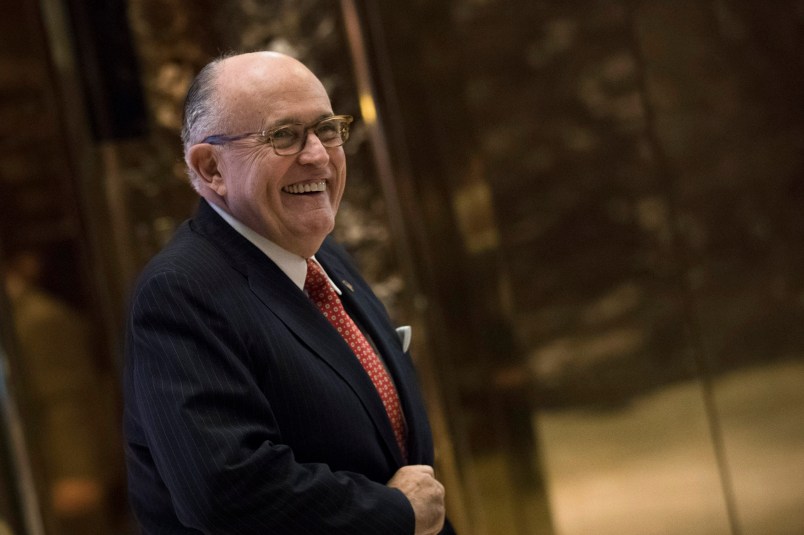Hospitals around the country are carefully rationing the treatments for COVID-19 that have been given to President Trump and those in his inner circle, which remain in very short supply as case counts in the U.S. continue to climb.
Rudy Giuliani said this week that he received the monoclonal antibody treatment manufactured by Regeneron after President Trump ordered his doctor to help the former New York City mayor. After leaving the hospital on Wednesday, Giuliani thanked the physician, Dr. Sean Conley, and credited it with helping him.
But Giuliani isn’t the only one in Trump’s orbit to have gotten the rare treatment. Ben Carson, secretary of housing and urban development, wrote on Facebook last month that, after having been “desperately ill,” Trump “cleared” him for the “monoclonal antibody therapy,” which he said “saved my life.”
And Chris Christie, hospitalized with COVID-19 in October, refused to participate in a trial of a Regeneron treatment out of concern that he would get a placebo, and instead gained access to a drug based on a similar technology manufactured by Eli Lilly.
All received monoclonal antibody treatments manufactured either by Regeneron or Eli Lilly, a scarce and expensive-to-manufacture medicine that has been found to stave off serious disease in early-stage COVID-19 sufferers.
And while Trump and his inner circle have managed to get potentially life-saving doses, the treatment remains extremely hard for most patients to gain access to. Hospitals are rationing the medicines, with some openly admitting that there’s just not enough for those who need the treatment to receive it.
In Utah and Massachusetts, for example, patients need to win a lottery to get the treatment. In Seattle, it’s being given via experimental trials because of the scarcity.
The Department of Health and Human Services bought around 300,000 doses of the treatment from Regeneron, and is distributing it around the country. But at current infection rates, that’s enough to treat little more than the number of new positive case that emerge in a single day in the U.S.
It remains unclear how Giuliani got access to the drug in the face of that massive scarcity. According to HHS statistics, D.C. is being allocated only 108 doses of Regeneron’s treatment per week.
Eric Topol, a cardiologist and professor of molecular medicine at the Scripps Research Institute in San Diego, told TPM that hospitals in that city had just started using the treatment on Thursday.
“The total number of doses that are allocated for California — 5,728 — that’s around how many people there are in that risk category getting sick every day here,” he said.
TPM found that various hospitals around the country are rationing the medicine, which the FDA recommends be used for people 65 and older, with a BMI of 35 and above. The New York Times reported that some FDA officials are concerned about how people connected to Trump have managed to get access to the treatments.
In Boston, Brigham and Women’s Hospital sent an email to staff saying “our ability to provide infusions of these therapies will be limited initially.”
According to the internal email, obtained by TPM, doctors will for now only use the medicine on those 65 and older or who have a BMI of 35 and up. But even within that group, the email informed staff, access will have to be limited.
“We will not be able to offer spots to all patients that meet these criteria, and will allocate spots by lottery with a certain number of spots in the lottery open only to patients who are socially vulnerable,” the email reads.
Hospitals in Utah are doing the same. Vanderbilt University Medical Center has the treatment but is rationing it, according to Dr. William Schaffner, a professor of preventive medicine at Vanderbilt. And in Washington state, at least two hospitals are providing the treatment to patients only as a part of ongoing clinical trials due to scarcity.
“It’s unavailable at the two hospitals I’m affiliated with unless you’re in a trial,” said Liam Yore, a Seattle ER doctor and immediate past president of the Washington chapter of the American College of Emergency Physicians.
In addition to scarcity, hospitals face another complicating factor in the time it takes to administer the treatment.
The FDA says that it takes over an hour to inject the monoclonal antibodies via an IV hookup.
“The facilities are not well set up yet,” Topol said, adding that areas which were hard-hit are finding difficulty making the space to feed the treatment to patients intravenously.
He added that he was baffled that those in Trump’s inner circle appear to have received the treatment.
“They have been superspreaders, denounced the public health mitigation strategies, and they are the few people getting this treatment, and they’re bragging about how it saved their lives,” Topol said. “In my view, its reprehensible — it’s bad enough that they got special treatment, but then they have to brag about it.”







“In my view, its reprehensible — it’s bad enough that they got special treatment, but then they have to brag about it.”
“All animals are equal, but some animals are more equal than others.”
We are here to serve Trump and his ilk.
We need to get over it, serve and die for these fine folks.
Trump cares for the “little guy” who gets Covid – there are organs to harvest and sell!
“Then let them eat cake and take tylenol.”
It’s not like I have problem with that: they’ve gotta be useful for something.
What worries me is how they’re gonna be prepared.
The preparation should bring out their flavor; but, do they have one? And, is it really something we want to bring out?